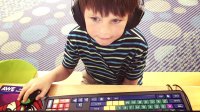Assistive Technology Can Benefit All Students
Five tools for reading, writing, and time management that can help all students—not just those with learning disabilities.
Your content has been saved!
Go to My Saved Content.Assistive technology tools were once meant for students with learning disabilities, but there is clear, documented proof that these tools are beneficial for other students. And I’ve observed students without learning disabilities learning more effectively using text-to-speech and speech-to-text tools—they read longer, write longer, and show a great improvement in spelling.
Text to Speech
Research supports the effectiveness of text-to-speech tools with students who struggle with decoding, fluency, and comprehension. Speak Screen for iOS is a built-in tool that can read text on a screen. Newer iOS devices can download the higher-quality Alex voice for a better experience.
The Read and Write for Google Chrome extension is a great alternative to Speak Screen, for those who don’t use iOS devices.
Voice Dictation
Siri’s dictation feature offers real-time speech-to-text conversion, recording the words you say as typed text. Students who struggle with writing benefit immensely when using this tool, which can be accessed on a Mac or iOS device. It is by no means perfect, but the more a user utilizes it, the better it functions. Alternatively, Google Docs’ voice typing feature is available in the Chrome browser.
Reader View
Safari Reader helps students avoid sensory overload by reducing the visual clutter on web pages. Reader pulls out ads, buttons, and navigation bars to reduce distractions. Most websites that are built with responsive web design in mind are also enabled with reader modes. When you find an article or other informational web page with a lot of text, you’ll most likely see the reader view button. I recommend turning this on before enabling a text-to-speech tool so that the screen reader doesn’t include the ads. Once reader view is enabled, you can tap the AA icon to adjust page colors, font sizes, and font types.
The Mercury Reader extension allows Chrome users on PCs, Macs, and Chromebooks to get the same benefits as they would with Safari Reader.
Clock Apps
The native clock app on an iOS device can be a powerful tool for students when used for time management and redirection. Students can set the timer when working on an assignment so that they can focus on that task before moving to another. They can also use alarms, labeling them appropriately for important reminders throughout the day.
Using Google’s timer and stopwatch via the search function is a great way for teachers to manage time in the classroom. If you want your students to read for 15 minutes or spend five more minutes on that narrative, this tool can help keep your students focused for the time you’ve allotted. You can tell Google Search to set a timer for a certain amount of time or simply enter the search terms ‘timer’ or ‘stopwatch’ to bring up the tool. The timer will beep within the Chrome tab when time is up.
Apple Classroom 2.0
Apple Classroom 2.0 allows teachers in one-to-one classrooms using iOS 10.3 or later, Bluetooth, and a Wi-Fi network to link students’ iPads together in a virtual class. This free app helps keep students on track and allows teachers to see their progress. The teacher can guide students through a lesson, launch the same app on all devices at the same time, or launch different apps for groups of students. One of my favorite features within Apple Classroom is the ability to lock all student iPads with the touch of a button or to lock them into one app, helping students stay focused on a specific lesson.
My 10-year-old daughter has always struggled with handwriting on paper. This exercise came with lots of tears and frustration. Supported with an iPad, dictation, and an on-screen keyboard, she has become a habitual writer who has written numerous books in the Book Creator app. Her stories are chock-full of detail and emotion. Writing is now a passion of hers.
It’s our obligation as educators, parents, and caregivers to help our students find tools that make learning accessible—for all learners, with or without a diagnosis.
For full written and video instructions on the iOS tools mentioned above, please see my free book iCan with iOS: Apps, Tools & Strategies for Students with Learning and Attention Issues.
